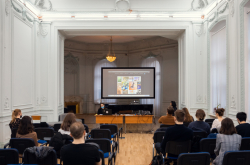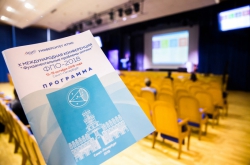New ways
In May of 2017, a new robotics lab was opened in Singapore – from the outside, it looks more like a movie set or a piece of modern art. Aluminum rods and lights line the walls and ceilings in a seemingly chaotic manner. The RACE Robotics Lab, with an area of 243 square meters, has two purposes: it is an exhibition hall for robots, as well as a place for work and study, where industrial and educational workshops are held. Metal panels hide the multitude of cables and outlets required by the lab equipment. On the outside, it is not like anything one would expect from a laboratory.

RACE Robotics Lab in Singapore
Another project – the design of laboratories at the University of Bristol – combines work areas with classrooms, rest areas, a spacious atrium and a library. One of its architect’s key solutions was to place the building’s complicated ventilation system on the outside of the building and cover it with metal paneling. Meanwhile, in the design of the new research center for Novartis in Boston, the main laboratories themselves became the centers around which the office spaces, rest areas and others were grouped around.
As Miguel Antunes Pinto, architect at PharmaArquitetos and member of EGNATON, points out, laboratories of the future will go through even more radical changes.
“In the next 20 years, laboratories will feature a lot more robots and machines that will help to both speed up their processes and eliminate human errors. We can expect advanced automation and less manual labor: there will be less furniture and more space for robots, we will no longer need to personally carry samples from one department to another – special delivery systems will take care of that. Such changes are already being introduced into the pharmaceutical industry, which, from my experience, is always at the forefront of laboratory development. For instance, many of these technologies are already applied in pharmaceutical production lines,” – says Mr. Antunes Pinto.
Russia’s first conference on laboratory space design will take place in St. Petersburg at ITMO University on October 26 and bring together the leading experts in design and use of modern research centers. This location was chosen because the university actively works in the field of biotechnologies and collaborates with top industrial and medical centers.
In addition, ITMO University is currently seeking out industrial partners for the creation of its new campus ITMO Highpark. It will serve as a platform for new, innovative research where new technologies in the fields of urban studies and smart cities will be tested, as well as a student campus.
Today’s goals

Denis Baranenko
Creation of modern research centers and laboratories requires more than just increasing safety, adds Denis Baranenko, head of ITMO’s International Research Center “Biotechnologies of the Third Millenium”.
“A laboratory space is a whole system comprised of the immediate workplaces of research staff and auxiliary components, offices and other infrastructure. The main task of the designers is to provide occupational safety. For instance, in my field of work – chemistry, biochemistry – we use combustible gases and other chemicals that have to be stored in a particular manner," – says the expert. – "Yet, after we’ve solved these basic problems, there’s the issue of raising efficiency, process automation and creating comfortable conditions for our staff to work in. Modern laboratory spaces are designed to free people from many mundane operation and let them concentrate on the more complex tasks that call for a creative approach.”
International standards
When creating such environments, modern laboratories in Europe and USA adhere to strict rules and standards. The GLP (good laboratory practice) standards dictate that any such laboratory can produce reproducible results that can be re-checked at other labs. In addition, a special requirement is that as many processes as possible are automated. Other standards, called GMP (good medical practice) are very similar in nature, but are applied to creators and manufacturers of pharmaceuticals. If a medical production does not adhere to GMP, their product will not be allowed to be sold on the European market.

Alexey Moskvin
Tightening the safety standards is one of the biggest trends in the international practice of lab design, says Alexey Moskvin, creator of portable labs for Russia’s environmental protection fleet. But lately, much more strict requirements have been applied to the ergonomics aspect, too. Things no one considered earlier on are now heavily regulated. Major companies are starting to pay more attention to resource efficiency. Due to the expensiveness of electrical power, they have to seek out new engineering solutions.
“We greatly focus on automatic equipment that monitors the levels of ventilation, which allows to relieve the workload of air conditioning systems. And that provides for greater energy efficiency. If we’re talking about a Northern country such as Russia, it is clear that heating 1,000 cubic meters of air is a lot more complex and expensive a task than heating 100. Hence, the seemingly overpriced engineering solutions help save a considerable amount of resources in the long run,” – explains Alexey Moskvin.
According to Miguel Antunes Pinto, global trends in lab space design are constantly changing. Major corporations are looking into such concepts as active co-working spaces, labs and optimization of working processes using cutting-edge technology and principles of sustainable development.
“One of the recurring problems of the last few decades was the inefficient use of laboratory spaces and buildings of the pharmaceutical industry. In essence, they became like energy-devouring “monsters”. Today, the biggest problem that we face when designing laboratory spaces in most countries is adhering to the principles of sustainable development and providing for quality implementation of these principles,” – says the expert. – “In EGATON, we focus on this very problem. We work on sustainability and aim to incorporate different points of view, take into account the opinions of both architects and engineers as well as producers, pharmaceutical companies and universities.”

Fabio Biffi, head of the company BICASA Srl – a manufacturer of lab furniture – says that the main requirements for lab space design today are for a more optimal integration of furniture and equipments, optimization of workflow and financial investments, as well as lab space flexibility - meaning that developers have to consider the lab’s future prospects during the development stage.
"When we design a laboratory, we need to focus on the tasks that will meet end-user requirements: space optimization, flexibility of projects, which makes it possible to take into account the prospects of development, and sustainability in terms of both energy-efficient and recyclable materials," – he notes.
Creativity for scientists
Today’s leading companies create complex, integrated projects for their laboratories. They account not only for lab spaces and primary and additional equipment, but also for the aesthetics of the architectural solution. An approach in which spaces are provided first and then filled up with furniture and equipment – even if nothing fits together – is a thing of the past.
The atmosphere that is formed in a lab is important, too, adds Denis Baranenko.
"These days there are more and more new trends in regards to making workspaces as comfortable as possible. It is no accident that the offices of IT companies that take care of their staff and pay attention to their effectiveness have become so well-known. They implement all sorts of additions to the environment by adding original and informal spaces, rooms for resting, creative spaces etc. Scientists are people too, and they work both physically and also spend an enormous amount of intellectual resources. In our work, ideas are also born within a particular type of atmosphere," – he says.
Labs in Russia: what works and what doesn’t
To bring the best international practices to Russian science centers, it is necessary to first solve the main issue that has to do with the discrepancies in standards and requirements. So far, even the basic elements that have to do with safety, ventilation or air conditions remain a serious issue in many of Russia’s labs, says Alexey Moskovin.
“I have spent a good amount of time designing laboratories, and in that time I came to the conclusion that the issues of gas tank storage or ventilation and air conditioning is always poorly solved.” – he said.

In addition, when designing lab spaces, developers have to constantly deal with inconsistencies between the construction standards in Russia and the European legislation to which the equipment is tailored. To solve these issues, first and foremost the domestic standards need to be set in line with the international ones, says Moskovin. However, he explains that Russian standards are indeed gradually changing to resemble those that are applied in Europe and the US.
Still, there are laboratories in Russia that already comply with the international ecological standards, such as the Skolkovo complex. According to Moskovin, their experience can be the first step to developing similar solutions in the rest of Russia’s labs, as well as the push needed to properly legislate the norms and requirements for lab spaces that would match the internationally accepted standards.
Relevant issues of the industry, certification, security, ergonomics, as well as the best international practices and solutions will be discussed by experts on October 26 at the 1st International Conference “Laboratory Space Design” at ITMO University.
The conference’s sponsor, company BICASA Srl, will hold a competition for students of ITMO University for the creation of the best lab design project. The main winner will be invited to a short-term internship at the company’s headquarters and production plant in Bernareggio, Italy.






